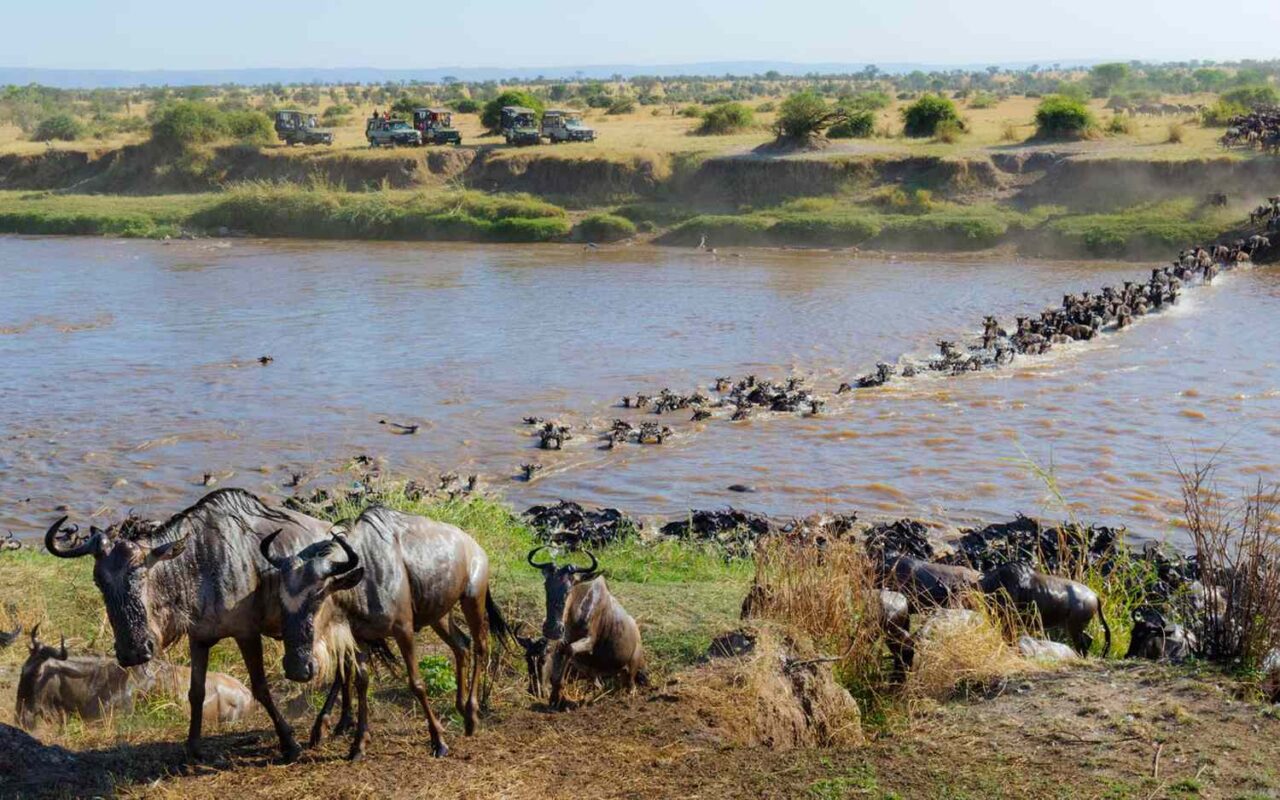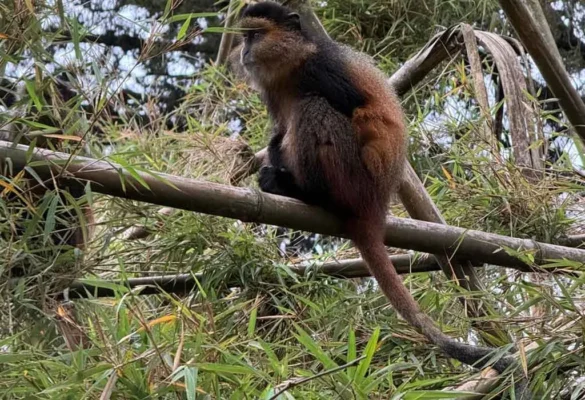
How Do I Book a Uganda Birding Safari?
November 26, 2025
How Do Gorilla Trekking Safaris Contribute to Local Communities?
November 27, 2025How Do Guides Track the Migration Patterns?
When travelers ask, “How do guides track the migration patterns?”, they are essentially seeking to understand the expertise, precision, and strategy behind observing one of nature’s most breathtaking phenomena. The Great Migration, spanning Kenya Safaris and Tanzania Safaris, is an annual movement of millions of wildebeest, zebras, and gazelles that traverses the Serengeti ecosystem and the Maasai Mara. This awe-inspiring spectacle is not only a cornerstone of Kenya Wildlife Safaris and Tanzania Wildlife Safaris, but also a vital component of the local ecology. Understanding migration patterns requires a combination of scientific knowledge, experience, and real-time observation, all of which expert guides from Renai Safaris employ to ensure that travelers witness this natural wonder in the most intimate and safe manner.
Introduction: Understanding the Secrets Behind Wildlife Migrations
Migration tracking is more than a tourist service—it reflects years of ecological research, behavioral studies, and deep familiarity with the terrain. By asking “How do guides track the migration patterns?”, travelers tap into the world of expert trackers who use both traditional skills and modern technology to predict movements. These guides consider rainfall patterns, river levels, grazing conditions, and predator-prey interactions to follow the herds across vast plains and rolling hills. For families and wildlife enthusiasts, this knowledge transforms a safari into an immersive learning experience, blending observation with understanding. Furthermore, combining these experiences with Rwanda Gorilla Trekking Safaris or Tanzania Chimpanzee Tracking Safaris provides a comprehensive East African wildlife adventure, highlighting both savannah and forest ecosystems.
Understanding the Ecology Behind the Migration
One of the most pressing questions travelers ask when experiencing Kenya Safaris or Tanzania Safaris is, “How do guides track the migration patterns?” Understanding the ecology of the Great Migration is crucial to answering this. The migration is driven primarily by rainfall and the growth of fresh pasture, which ensures that herbivores have enough food to sustain the enormous herds. Wildebeest, zebras, and gazelles move in search of nutrient-rich grazing lands, following seasonal rain patterns that shift across Tanzania’s Serengeti plains and Kenya’s Maasai Mara.
Guides track these patterns by combining ecological observation with years of field experience. For instance, rainfall data, river flooding, and vegetation growth are indicators of where the herds will move next. During Kenya Wildlife Safaris, expert guides often rely on knowledge passed down through generations and supported by modern technologies such as GPS tracking, aerial surveys, and remote camera traps. These methods allow guides to predict the movement of the Great Migration, ensuring tourists witness river crossings, calving events, and predator-prey interactions at optimal times. For avid birdwatchers on Kenya Birding Safaris, migration periods also coincide with avian movements, making this a multi-layered observation experience. Travelers combining Rwanda Gorilla Trekking Safaris with Kenya Safaris gain a broader understanding of East African wildlife, spanning savannah plains, forest habitats, and primate ecosystems.
Traditional Tracking Skills and Field Expertise
When asking, “How do guides track the migration patterns?”, it is important to recognize that much of the skill comes from hands-on experience. Renai Safaris employs guides who have years of practice in reading animal behavior, tracking hoofprints, and interpreting the signs of wildlife movement. For Tanzania Wildlife Safaris, guides observe the behavior of leading animals within a herd, as these often indicate imminent directional changes. They monitor predator movements, grass condition, and even subtle environmental cues such as wind direction, which can hint at herd location or river crossing points.
This traditional tracking knowledge complements modern tools like satellite imagery and GPS collars. By combining field observation with technology, guides ensure a high probability of locating herds while maintaining safety for both animals and tourists. On Kenya Safaris, guides may also liaise with other local experts or national park rangers, sharing real-time information about herd positions and river levels. For travelers participating in Tanzania Chimpanzee Tracking Safaris or Rwanda Gorilla Trekking Safaris, these same principles of tracking—observation, patience, and knowledge of habitat—are applied, illustrating a consistent methodology across East African wildlife experiences.
Predicting River Crossings and Herd Movements
One of the most dramatic aspects of Kenya Best Safaris and Tanzania Best Safaris is witnessing river crossings during the Great Migration. For many travelers, the question “How do guides track the migration patterns?” is closely tied to this thrilling spectacle. Guides use environmental cues, herd movement history, and local knowledge to anticipate when thousands of wildebeest and zebras will cross rivers like the Mara or Grumeti. Timing is crucial: river crossings can be unpredictable due to flooding, predator presence, and terrain changes.
Guides also assess herd size, direction, and the presence of scouts leading the way. These scouts test conditions before the bulk of the herd follows, providing critical information for safari scheduling. For Kenya Wildlife Safaris, being at the right place at the right time enhances the likelihood of witnessing dramatic predator-prey interactions as lions, crocodiles, and hyenas exploit the herds’ vulnerability. Travelers seeking a multi-experience adventure can combine these Kenya Safaris with Rwanda Gorilla Trekking Safaris, allowing them to witness both the savannah’s raw energy and the quiet majesty of primate encounters in dense forests.
Technological Advances in Migration Tracking
In today’s age, technology plays a significant role in enhancing the accuracy of Tanzania Safaris and Kenya Safaris. Travelers often ask, “How do guides track the migration patterns?” Modern tools such as satellite imagery, GPS collars, drones, and camera traps complement traditional tracking knowledge. GPS collars attached to select animals allow conservationists and guides to monitor herd movements remotely, offering precise data about location, speed, and direction.
During Tanzania Great Migration tours, these technologies enable safari guides to provide real-time updates to tourists, ensuring maximum chances of witnessing iconic moments like calving or river crossings. For Tanzania Chimpanzee Tracking Safaris, camera traps and GPS data help locate chimpanzee troops while minimizing disturbance to their natural behavior. Similarly, combining these technological tools with Rwanda Gorilla Trekking Safaris enhances the visitor experience, demonstrating how East African safaris are increasingly integrating innovation with tradition to provide both safety and optimal wildlife observation.
Combining Cultural Experiences with Wildlife Tracking
A comprehensive safari is not only about animal observation; it also includes cultural immersion. Travelers often wonder, “How do guides track the migration patterns?” while also wanting to know how to combine wildlife with cultural experiences. On Kenya Cultural Safaris, visitors interact with Maasai and Samburu communities, learning about traditional pastoral practices that coexist with migratory wildlife. This provides context for understanding how local knowledge contributes to tracking and protecting the Great Migration.
Similarly, in Tanzania, guides often collaborate with local communities along migration routes to gather observations about herd movements, grazing patterns, and river levels. These insights not only enhance the safari experience but also support conservation initiatives. Combining Rwanda Gorilla Trekking Safaris with Kenya Safaris or Tanzania Safaris creates an enriching itinerary, blending savannah wildlife, primate encounters, and cultural learning. This approach allows travelers to witness ecological interconnectivity, demonstrating how human and wildlife communities coexist and thrive in East Africa.
Seasonal Insights: Timing Your Safari for Maximum Experience
One of the most frequently asked questions by safari-goers is: “When is the best time to track the migration patterns?” Timing is crucial for witnessing peak wildlife activity during Kenya Best Safaris or Tanzania Best Safaris. The Great Migration follows a predictable annual cycle, influenced by rainfall and grazing availability. From December to March, herds congregate in southern Serengeti for calving. Between April and May, rains disperse herds across the plains. By June to July, wildebeest begin moving north toward the Maasai Mara, culminating in the dramatic river crossings between July and September.
Guides use this seasonal knowledge to plan itineraries, ensuring tourists experience Tanzania Wildlife Safaris and Kenya Wildlife Safaris at the most opportune moments. Combining these trips with Rwanda Gorilla Trekking Safaris or Tanzania Chimpanzee Tracking Safaris allows travelers to create multi-ecosystem adventures, timing both savannah and forest wildlife encounters perfectly. Renai Safaris emphasizes that understanding migration cycles transforms a safari from a casual observation to a highly curated and unforgettable wildlife journey.
Conclusion: Mastering the Art of Migration Tracking
In conclusion, the question “How do guides track the migration patterns?” encapsulates the depth of knowledge, experience, and dedication required to lead successful Kenya Safaris and Tanzania Safaris. Guides rely on a blend of traditional field skills, ecological expertise, and modern technology to monitor herd movements, anticipate river crossings, and provide tourists with unforgettable wildlife encounters. For families and adventure-seekers, combining Kenya Wildlife Safaris, Tanzania Wildlife Safaris, and Rwanda Gorilla Trekking Safaris creates a full-spectrum East African adventure that spans savannahs, forests, and culturally rich communities.
Understanding how guides track migration not only enhances the safari experience but also deepens appreciation for East Africa’s unique ecosystems. From observing the Tanzania Great Migration to enjoying Kenya Birding Safaris, Kenya Cultural Safaris, or Tanzania Chimpanzee Tracking Safaris, every aspect of the journey is informed by expert tracking knowledge. Renai Safaris is dedicated to ensuring that travelers experience East Africa’s wildlife in a safe, educational, and immersive manner, establishing a standard of authority, trustworthiness, and unparalleled safari expertise.



